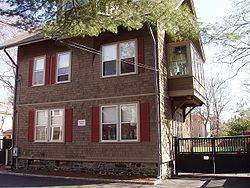Built 1928 Designated NHL May 15, 1975 Added to NRHP 15 May 1975 | NRHP Reference # 75000298 Opened 1928 | |
 | ||
Similar Lechmere Canal, Museum of Comparative Zoology, Harvard Square, Cambridge Common, Semitic Museum | ||
The Percy W. Bridgman House is an historic house located at 10 Buckingham Place in Cambridge, Massachusetts. It is a National Historic Landmark, notable for its associations with Dr. Percy Williams Bridgman, a physicist, Nobel Prize winner, and Harvard University professor. It is now part of the Buckingham Browne & Nichols (BBN) Lower School campus.
The house is an architecturally undistinguished 2-1/2 story house built about 1920 in a Neo-Rationalist style. At the time of its designation as a National Historic Landmark in 1975, the house had not been significantly altered since Dr. Bridgman's death in 1961. It was acquired by the BBN School not long after his death, which has used it for a variety of purposes, including as a faculty residence and lounge. It is used for school offices.
Percy Bridgman (1882–1961) was born in Cambridge, raised in Newton, and educated at Harvard. After receiving his Ph. D. in physics in 1908, he was invited to join the Harvard physics faculty, where he remained for the rest of his life. Bridgman's primary area of research was in the area of high pressure physics. He was awarded the Nobel Prize in Physics (the fifth American to be so honored) in 1946 for his development of equipment for advancing research in that field. He also wrote extensively on the epistemology of physics and the sciences, advancing ideas that evolved into the field of operations research during the 1940s. Bridgman moved into this house in 1928, and lived there for the rest of his life.
